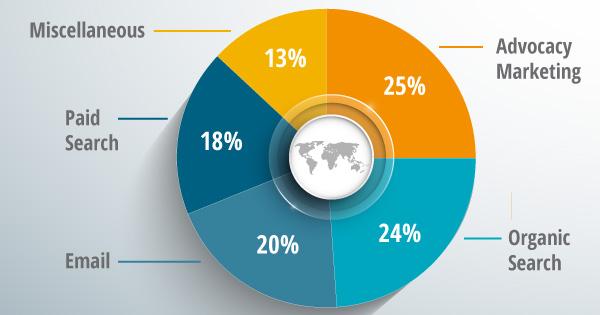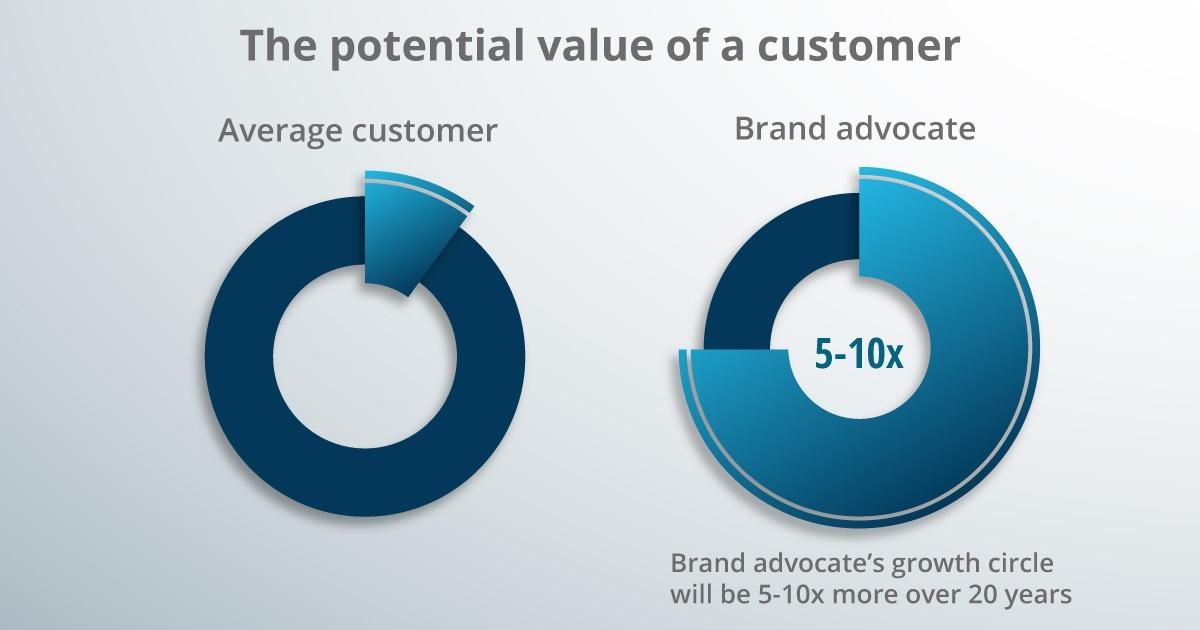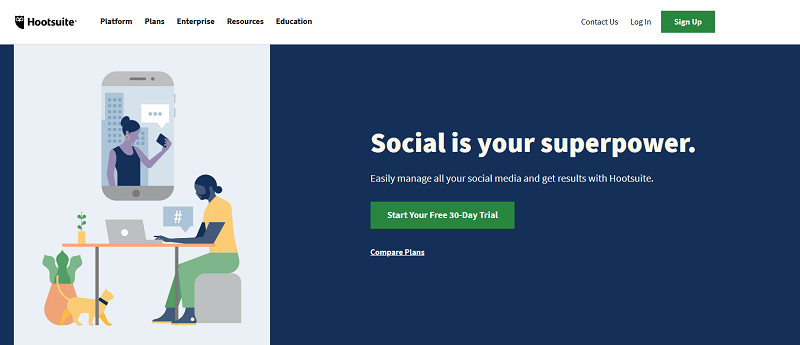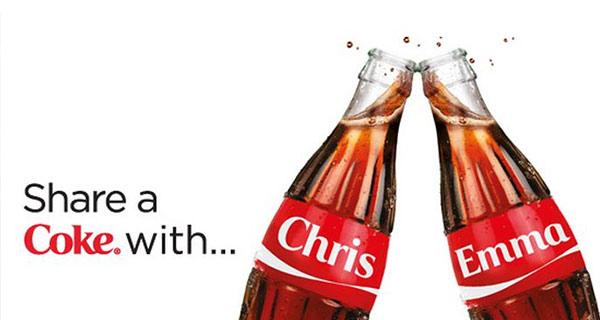Brand buzz: The ultimate guide to all things brand advocates
| July 15, 2020

Growing technology and social media options have increased the potential value of brand advocates.
The reality of today’s advocacy is there are limitless sources to promote a brand if someone is so inclined. Today, spreading the word means more than telling a few friends or family – it means telling the world.
What is a brand advocate?
A brand advocate promotes your brand without any external incentive to do so, often by word-of-mouth. They are usually a customer who had a great experience with a brand and felt the need to tell others about it. A brand advocate is valuable because they drive customers to your brand.
Marketers cite advocacy marketing as typically their most profitable and cost-friendly online marketing method.
3 distinct reasons why brand advocates are so important
We like to think of loyal customers as some of our most profitable customers, but upon further examination, it becomes clear that a brand advocate is much more valuable.

Let’s compare the two to get an example of why this is. First, consider a loyal customer. They will likely purchase our products and services every time they need something from our brand industry. This then continues over their lifetime.
Now, consider that a brand advocate will essentially do the same. They love our products so much that they buy them over the competition whenever possible.
On top of that, they will voice positive opinions about our brand and new products or services we release. This potentially leads to more sales and numerous new customers.
Even if the advocate never purchased from us (unlikely), they are still more valuable than a loyal customer.
Why is this? What makes a brand advocate so effective at promoting a brand? And how does modern technology apply? Here’s a further breakdown:
1. The power of social trust
Picture for a moment that you’re watching television and an advertisement comes on, in which a celebrity you know endorses a new e-reader. They might show themselves using it in a montage, give a few benefits it provides them and suggest reasons why you need it.
Now consider that you and a close friend are having lunch, and the topics of books comes up. They tell you that they’ve been able to read so much more lately because of how nice their e-reader is.
They explain the different benefits and how it has helped them overcome common reading obstacles.
You have some uncertainties about the screen that you ask about. They point out that their e-reader allows for bigger fonts to avoid eye strain.
In the above two scenarios, people are much more likely to buy the e-reader their friend uses. They trust their friend and value their recommendation over the celebrity. There’s a lot of different reasons for this.
The biggest reason is that they know and trust a friend. They value their opinion and believe they’re being truthful and not just trying to make a sale.
Also, their friend’s needs are likely to be similar to their own (since most people aren’t celebrities). Finally, they were able to ask and receive answers about the product on the spot.
Even though brand advocacy isn’t always the difference between a celebrity advertisement and a close friend endorsing a product, we still see the power that a brand advocate possesses.
If the advocate speaks out positively for our brand and products to total strangers, there’s still a good chance they are given a high level of trust. It’s a lot easier for people to trust their peers who have nothing to gain by convincing us that a brand is good or bad.
Now let’s consider how far the brand advocate’s messages can spread.
2. The outreach of contemporary advocacy
To truly understand the potential power of a brand advocate, we have to consider the modern realities of technology and social media.
Even the most well-connected brand advocates in the past were fairly limited. Sure, they were able to tell their friends, family and maybe a few coworkers about how great a brand is. And this was absolutely important.
However, it pales in comparison to the potential outreach of well-connected brand advocates today. Further than friends, family and coworkers, which modern advocates can still give recommendations to, there are now many different platforms to branch out to.
First, there’s social media, where users connect with hundreds and thousands of minor acquaintances. There’s also online review platforms, where an advocate could potentially, in great detail, recommend a brand or rate a product.
It’s not hard to see that brand advocates have some serious value – how much is the question.
3. The measurable value of brand advocates
A brand advocate, depending on their outreach, could be worth potentially much more than the average customer, especially long term.
It’s estimated that over 80% of customers prefer recommendations from someone they know over other sources. Combine this with the fact that a word-of-mouth recommendation is believed to be the driving force of over 40% of purchases, and you have quite a valuable commodity.

In today’s world of transparency, a brand advocate is one of the best weapons to have on your side. Websites that offer customer reviews and ratings are a constant reminder that it’s important to have someone praising your brand.
Another lesser-known way that brand advocates help is by creating content without any external incentive. Essentially, they are creating content which promotes your brand and you don’t even have to pay them for it.
This creation certainly helps limit the marketing budget from overspending on content creation, since their job is being done for them essentially.
Use our branding guide to learn more about this topic and others.
Now that you have some reasons why a brand advocate is so valuable, let’s make sure you know how to attract new ones.
Dynamic methods to attract new brand advocates
It’s pretty clear how important brand advocates are, so how do we go about creating them? I’ve come up with some methods that are sure to do the trick.
Focus on brand experience
What better way to entice a customer to spread the good word about your brand than an experience they love and connect with?
Not only is a brand experience memorable and long lasting, but it gives customers a reason to tell others about your brand.
It’s not that hard to see why this would be the case, either. Think of how common it is for someone to relay a brand experience to someone they know.
Maybe the movie theater they took their kids to had characters from the movie in costume greeting the youngsters as they entered and exited the screening. Certainly they would tell others, especially those with kids themselves, of their good time at the film.

Think of ways your brand can create unique, memorable experiences for customers. Chances are these powerful experiences will form lifelong brand advocates.
Implement compelling brand storytelling
“Storytelling is the most powerful way to put ideas into the world today.” – Robert McKee
A google search can seem like a common thing nowadays. Users log on to the popular search engine to quickly find an answer to a question, new website, local restaurant and more. Chances are that there’s not much thought given into what they search after the fact.
However, because of the genius idea of Google to turn their yearly searches into a compelling storytelling campaign, users are now seeing searches as impactful, meaningful and important.
The idea is simple: Each year, Google compiles user searches and creates a YouTube video that turns the most popular ones into a fascinating tale. A theme typically emerges, and it helps users connect with the idea that their input builds history.
This type of storytelling helps brands connect with customers. It gives brands a chance to give valuable insight into what they stand for and who they really are. This can help them stand out to customers.
As we see each year after Google tells their story, there is a lot of intrigue, connection, hype and buzz surrounding a powerful brand story.
Think your brand might have its own story to tell?
Offer a quality and reliable product or service
There are a lot of different factors that help create brand advocates. One of them, probably the most important foundation, is how quality the product you provide is.
This seems pretty logical, since all the experiences with a brand are all for not if the end product or service is lacking. No one is going to recommend a bad product just because the customer service was top notch.
Taking it a step further, some customers stick with a brand they dislike if their product or service is good.
It’s easy to say that the key to gaining brand advocates is to create an amazing product – every company tries to offer good products. The key is to make adjustments based on research until you’ve got it right.
Another aspect that can’t be ignored is reliability.
When most people hear reliability, they assume that it means something that works correctly or is dependable 100% of the time. Obviously, this isn’t possible, even for the most sturdy and durable products or most committed brands.
However, reliability does require a level of responsibility that far exceeds the average. When a customer is in need, a reliable brand responds accurately.
The best way to stay reliable is to truly listen to customers and figure out how their requirements might have changed.
Identify advocates; encourage advocacy
Do you know why it’s so important to understand who your brand advocates are? We sometimes forget that just because an advocate asks on our behalf, doesn’t mean that we can’t be proactive.
Finding our brand advocates
When a brand knows who their advocates are, they can stay ahead of the feedback their next project is bound to receive. For example, if a brand is planning on releasing a new product line within the next three months, they could notify and connect with their advocates about it.
Furthermore, a brand advocate is much more willing to give valuable insight into your recent services, helping build your feedback without having to bother unwilling customers for comments and/or criticisms.
If you need some extra help researching and finding new brand advocates, consider a software system such as Hootsuite to handle the workload for you.

Encouraging advocacy
Remember that just because a customer is a brand advocate doesn’t mean that you can’t nudge them in the right direction to share a little more.
In fact, there are a lot of brand advocates who would love to spread your brand message but are limited by accessibility or other factors.
How do we fix this? The simplest answer is to seek out unique, creative ways to encourage advocacy. For example, some brands offer rewards for recommending them to a friend or family member.
More recently, brands have put easy-to-share links on digital products and services that further incentivize advocacy.
Don’t forget that this type of encouragement will only be effective on those who already wish to advocate for your brand. Offering a reward to share a bad product isn’t going to work.
Companies who embolden advocacy
Here are some companies to serve as an example of a good strategy to promote advocacy:
Coca-Cola
Coca-Cola is one of the best examples of a brand who promotes advocacy effectively. There are quite a few campaigns that stand out as powerful ways to create new advocates. I’ll discuss my personal favorites.
First, there was the ingenious ‘Share a Coke’ campaign, which involved printing the words “Share a Coke with…” and common names were printed, giving customers a chance to buy one of the sodas and give it to their friend, coworker or family member if they shared that name.

Not only was this a really good idea, creating a lot of buzz and togetherness as a result, but it also directly encouraged advocacy. Certainly, it’s a powerful way to get someone to spread the word about your brand around.
Another campaign they ran was the ‘Happiness Machine’ project, where special Coke vending machines were set up in public, only to purposely malfunction and give more soda than purchased (a lot more, in fact).
These moments were captured on camera and spread via the internet, mostly on YouTube. The videos showed people laughing, sharing and enjoying the fun brought on by the Coke machine’s ‘error’.
Starbucks
The popular coffee chain came up with a great idea to generate and potentially identify brand advocates. Their ‘Tweet-a-coffee’ program gave customers the option to use social media to purchase coffee for others.

Part of the reason this was so successful is because it promoted social togetherness, which always bodes well for a brand’s image.
Another reason this was such a positive for Starbucks is they were able to use the social media purchases and identify future brand advocates that they could consult for other projects or feedback.
Closing thoughts
Marketing with the intention of creating brand advocates should be integrated into your everyday marketing processes if you truly want to succeed. Think of the many ways you can provide customers with a great experience and product, then push onward to encourage advocacy.
Chances are, there are more brand advocates within your potential reach than you think. Once you begin looking for them, and helping them along, they’ll start to appear everywhere. Good luck!

